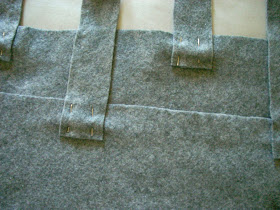

First thing this morning I made a simple paper pattern 7.5 inches long and 1.5 inches wide. Then I cut ten of these shapes from a long leftover strip of charcoal-gray felt. These will be the loops from which the two felt panels will be suspended across the front of the
baby dwelling still slowly and cautiously being constructed by my daughter and son-in-law, who expect to be putting it into use in about two months. Considering how much slower my progress was today than I had hoped, it is comforting to repeat the fact that the absolute deadline for completion is still a little ways off.



Each of the ten proto-loops needed to be lined with grosgrain ribbon to prevent stretching. I ran out of ribbon after eight loops, and was not altogether sorry of a pretext to get out into the sunshine and walk up to
Cliff's Variety in the Castro for additional ribbon. It was only when I got back and settled down to attach the ribbon pieces by hand (there being no adequately attractive way to do this on the sewing machine) that the job seemed to stretch out endlessly toward infinity. After a while, I felt like one of the lab-coat-wearing middle-aged ladies I saw in a recent documentary about the couture operations on the top floor of the rue Cambon atelier in Paris – ladies who spend weeks turning one of Karl Lagerfeld's lightning-elegant sketches into a flawless, handmade Chanel ballgown. When a major fashion show approaches, they work all night. Stitching, stitching, stitching.



By evening all ten loops were securely lined with ribbon and were pinned into their proper places on the panels, but I gave up at that point and went out for take-out comfort food – a shawarma (with hot sauce) from
Truly Mediterranean on 16th Street near Valencia. It was a sort of marvel to see the hopping scene all about me as the inner Mission enjoyed a holiday weekend and San Francisco enjoyed balmy spring weather at last. I felt even more like a middle-aged lab-coated lady, blinking in the slanting sunlight after losing complete track of how long I had been immured with my needle and thread. Like those ladies also, I felt obscurely guilty that I had not accomplished more on the path toward realization of the Governing Vision (which in this case instead of belonging to Monsieur Karl belongs to an even more formidable creative force – viz, my daughter).





















































